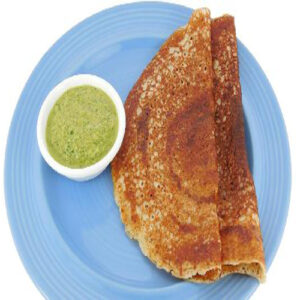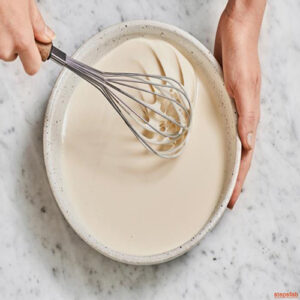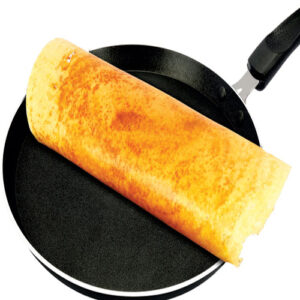Perfecting Buttermilk Dosas on a Non-Stick Tawa: The Ultimate Guide

Hungry yet? If you’ve ever wanted to master the art of creating these delectable Buttermilk Dosas, you’re in for a treat. In this guide, we’ll walk you through the steps to make these dosas using a non-stick tawa. Whether you’re a seasoned chef or just starting out, get ready for a delightful culinary adventure that combines tradition and convenience to give you the best breakfast experience.
Ingredients:
Before you dive into the kitchen, gather these ingredients:
For the Dosa Batter:

1. 2 cups rice
2. 1/2 cup urad dal (black gram lentils)
3. 1/4 cup flattened rice (poha)
4. 1/2 cup sour buttermilk
5. 1/2 teaspoon fenugreek seeds (methi seeds)
6. Water (for soaking and grinding)
7. Salt (to taste)
For the Buttermilk Dosa:
1. Prepared dosa batter
2. Finely chopped onions, tomatoes, and green chilies (optional)
3. Freshly chopped coriander leaves (optional)
4. Oil or ghee (clarified butter) for cooking
Step-by-Step Guide to Crafting Buttermilk Dosas on a Non-Stick Tawa:
1. Soaking the Ingredients:
o Start by giving the rice, urad dal, and fenugreek seeds a good rinse.
o Let the rice and fenugreek seeds soak in one bowl and the urad dal in another. Cover them with water and let them soak for about 4-6 hours.
o The flattened rice (poha) needs a soak too – around 20-30 minutes before grinding.
2. Creating the Batter:
o Once soaked, grind the rice, urad dal, and fenugreek seeds separately to a smooth consistency using a grinder. Gradually add water as needed.
o Mix the rice and urad dal pastes in a big bowl. Add the tangy buttermilk and salt. Give it a good stir and allow it to ferment for 8-10 hours or overnight. The fermentation adds that wonderful flavor and texture.
3. Crafting Your Dosas:
o After fermentation, give the batter a gentle stir. If it’s too thick, add a touch of water to make it just right for pouring.
o Heat your non-stick tawa on medium heat. Let it warm up gradually. The right tawa temperature ensures even cooking and that coveted crunch.
4. Cooking Magic:
o Once your tawa is ready, ladle some dosa batter onto the center.
o Use the back of the ladle to spread the batter in a circular motion, creating a thin dosa.
o Drizzle a bit of oil or ghee around the edges and on top for extra flavor.
5. Golden Goodness:
o Allow the dosa to cook until the edges turn a beautiful golden brown and get wonderfully crisp.
o With a flat spatula, gently lift the edges and fold the dosa in half or roll it, depending on your preference.
o Keep cooking for a few moments until the dosa reaches its crispy, golden glory.
6. Serving Up Your Creations:
o Carefully remove the dosa from the tawa and serve it piping hot with coconut chutney, zesty sambar, or any accompaniment you adore.
Top Tips for Dosa Perfection:
1. Tawa Temperature: Ensure your non-stick tawa is properly heated before you start pouring the batter. Test it by sprinkling a few drops of water – they should sizzle and vanish.
2. Consistency is Key: Aim for the right batter consistency – not too thick and not too runny. This helps you spread it evenly.
3. Flavor Through Fermentation: Give your batter enough time to ferment. The longer it ferments, the more flavorful and textured your dosas will be.
4. Oil or Ghee Magic: Using a bit of oil or ghee on the tawa elevates both flavor and crispiness.
5. Spreading Magic: If you’re new to dosa-making, practice spreading the batter using the back of the ladle. It requires some dedicated practice, but you’ll grasp it eventually!
6. Get Creative: While classic buttermilk dosas are divine, you can experiment with toppings like onions, tomatoes, bell peppers, or fresh herbs.
7. Enjoy the Learning Journey: Your first dosa might not be perfection – and that’s perfectly okay! Like any skill, dosa-making gets better with practice.
Non Stick Tawa :

The Non-Stick Tawa Advantage: While cast iron tasas have their charm, the non-stick tawa brings a modern touch to this classic recipe. Its slick surface requires less oil or ghee, making your dosas healthier without sacrificing that satisfying crunch. Plus, flipping and maneuvering dosas becomes a breeze, even for those just starting their culinary journey.
Bonding Over Breakfast: Cooking dosas on a non-stick tawa can also be a wonderful way to bond with loved ones. Imagine a morning where the family gathers around the kitchen, each person taking a turn to create their masterpiece. From pouring the batter to watching it transform into a crispy delight, dosa-making on a non-stick tawa becomes a shared experience that’s as heartwarming as the dosas themselves.
Diverse Accompaniments: While traditional coconut chutney and sambar are classic companions, don’t hesitate to explore beyond the usual. A dollop of creamy avocado chutney, a zingy mango salsa, or even a tangy tamarind chutney can add exciting dimensions to your dosa journey. With a non-stick tawa simplifying the cooking process, you’ll have more time to experiment with these delectable sidekicks.
Conclusion:
Creating Buttermilk Dosas on a non-stick tawa brings a taste of tradition and comfort to your kitchen. The blend of tangy buttermilk and the irresistible crunch of the dosa is an experience you’ll cherish. Remember, making dosas is both science and art, so enjoy the learning curve and relish the journey to dosa mastery. Happy cooking and even happier eating! Your breakfast table is about to become a feast of flavors.

2 Replies to “Perfecting Buttermilk Dosas on a Non-Stick Tawa: The Ultimate Guide”